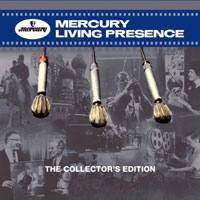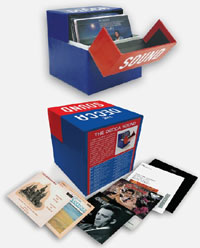The Decca Sound
Mercury Living Presence • The Collector's Edition
ptical discs might be slipping quietly into the twilight shadow cast by computer audio’s pitiless glare, but every cloud has a silver lining -- or in this case, two. As record companies scramble to rake in every last shekel from the fading format, they’re churning out cut-price goodies just as fast as they can, presenting them, boxing them and offering them in as many different ways as they can dream up in the vain hope of parting us from even more of our hard-earned cash, often for something we already own. First up were the "Deluxe Editions," remastered versions of the original albums paired with a second disc of outtakes, rarities or live takes in a fancy gatefold case. Although some are inevitably better than others, depending entirely on the quality of the remastering and the imagination that’s been put into selecting the extra material, these discs have proved deservedly popular -- and are well worth investigating. More recently, and with the precipice creeping ever closer, multi-disc box sets have become the order of the day, with our most-respected classical record labels raiding the vaults to serve up the musical equivalent of an all-you-can-eat buffet. First to cross my horizon (and subsequently, my threshold) were two EMI offerings: Sir John Barbirolli: The Great EMI Recordings, comprising ten discs, including his seminal readings of Finlandia, Mahler Symphony No. 5 and Rückert-Lieder, Vaughan Williams Symphony No. 5 and Tallis Fantasia, and the Elgar Enigma Variations -- all for under £30. Vaughan Williams: The Collector's Edition has 30 discs featuring the work of Sir Adrian Boult, Sir David Willcocks, Dame Janet Baker, Vernon Handley and a host of other British greats -- for the princely sum of £47.50. Okay, so the Barbirolli box is missing the Du Pre Elgar Cello Concerto, and you don’t get Boult’s fabulous readings of the Vaughan Williams symphonies (although you do get most of his choral recordings). The discs also come in simple paper sleeves, but even so, it’s churlish to complain. Even these two gems pale into insignificance when compared to a pair of box sets I’ve recently received. I first became aware of the Mercury Living Presence: Collector’s Edition set (and the almost-matching Decca Sound set) through postings on the Phonogram list. Now, Phonogrammers are, by definition, primarily interested in vinyl (although file-based replay is rapidly gaining traction), so seeing them getting all hot and bothered over the despised silver disc definitely piqued my interest. Of course, all becomes clear once you look at the contents on offer, which read like the vinyl wish list of any self-respecting classical-record collector. Okay, so these are all stamped on nasty little silver discs, rather than sumptuous 12" slabs of vinyl, but the performances -- just listen to those performances. With 50 discs in each box -- and even allowing for the odd makeweight or two -- there’s no way you can miss here. Let’s start with the Mercury box, which contains most of the CDs from the original Mercury release cycle as remastered by Wilma Cozart Fine, who was also the original producer. With so many of these titles rated highly in the record-collecting community at least a few of them will probably have sneaked into your collection, but that still leaves plenty of gems to sort through. With 50 discs in all, I’ll just pick out a few highlights, otherwise this will start to read like a laundry list. Top of the heap would have to be the Starker recordings (especially the Bach Cello Suites -- which were also repressed on vinyl by Speakers Corner -- and the Dvorak Cello Concerto), closely followed by Dorati and Janis, all of which are familiar audiophile fodder. But there are other gems lurking here: Kubelik conducting Smetana’s Ma Vlast (in mono); Skrowaczewski’s coruscating Shostakovich's Fifth; Szeryng’s Schumann and Mendelssohn violin concertos. The only glaring omission I can spot is the various Dorati readings of Respighi (Ancient Airs and Dances, The Birds, Brazilian Impressions, Pines and Fountains), which are both popular and highly regarded, making their total absence something of a puzzle. No, I haven’t played every disc here -- and there are one or two I’ll probably never reach for -- but those I have compared to my well-used original CDs sound rather better. Soundstages are more spacious and more stable, and tonality is more even, with none of the glare that can mar the earlier discs. Even if they don’t come close to a tip-top, early vinyl issue, both price and accessibility are considerably better. In fact, at £76 you get all 50 discs for less than the price of a single decent pressing of one of the higher-rated LPs reproduced here, so it’s hard to fault this box on musical grounds or in terms of value. But what’s even better is the presentation. An excellent booklet covers the history of both the Mercury label and the performers represented here, while the discs themselves are held in card sleeves that reproduce the original cover art. There’s also a bonus CD containing an interview with Cozart Fine, covering the early recordings, complete with illustrative examples from Kubelik’s recordings of Pictures at an Exhibition and Ma Vlast. At an aggregate price of around $3 a disc, you really can’t go far wrong with this astonishing set. The Decca Sound has a slightly higher price (£95) and a more stylish, confident look about it, with a bold, two-tone, split-lid box. Inside, it’s the same story as the Mercury set: a comprehensive booklet covers the history of Decca’s recordings, from "ffrr" to digital, including photographs of many of the performers and recording venues, whilst the discs (all in stereo) are once again stored in card sleeves with the original artwork on the front. Here, however, they cover a far wider historical spread, running from 1956 through to 2009. But fear not, many of the most sought-after Decca titles are included: Argenta’s Espana [SXL 2020]; Britten’s War Requiem [SET 252-3]; Monteux and the LSO’s Daphnis Et Chloe [SXL 2164]; Maag’s Mendelssohn In Scotland [SXL 2246]; the Kertesz/VPO Dvorak New World Symphony [SXL 2289] just for starters. Of more recent vintage: the Pavarotti/Sutherland Turandot (highlights) [SET 561]; Bartoli’s Italian Songs [440 2972]; Joshua Bell and Janine Jansen Violin Concertos. On top of that, 19 of the discs feature "bonus" tracks, added to the original album lineup to fill out the CD. In some cases these rather more than double the value of the disc. So, Espana gets the addition of Argenta conducting the Tchaikovsky Violin Concerto, with Alfredo Campoli as soloist. As well as the Kertesz "New World," you get Dvorak’s 8th Symphony too, while the Dorati Rite of Spring also includes The Firebird. These extras are included on the contents listing, but if you are familiar with the original albums and their distinctive artwork, then they come as a pleasant surprise indeed. Another thing I really like is the amount of detail contained in the booklet regarding the recording dates, venues, etc. The notes are unusually comprehensive, and although this information appears on the original albums, it’s exactly the sort of detail that gets expunged from later releases. Again, there’s far too much on offer here for the recordings to be consistent, or even to comment in detail, but rest assured, if the contents of this box fail to stimulate your interest, then your musical synapses have probably been cut. Don’t take my word for it -- take a look at the full list online; just make sure that you’ve got tissues handy to mop up the embarrassing dribble. One listen to Kertesz and the Vienna’s dramatic opening to Dvorak’s old, orchestral war-horse might just convince you that this is a new world indeed. Impressive scale and dynamics deliver tension and drama without any of the softening effects of later and rather more twee performances. Best of all, there’s none of the shrillness that mars many later vinyl pressings, just real power and intensity from a world-class orchestra captured at the top of their game and commanded by a baton of real authority. Those familiar with the original albums are also in for a second pleasant surprise. Anybody who is used to hearing these records replayed using the RIAA EQ curve (rather than the Decca) will marvel at the natural balance and weight these performances really possess. The only downside is that the experience might just drive you to find a phono stage with switchable EQ, which could make this one of the more expensive bargains you’ll have purchased! Take these two boxes together and all told they add up to 101 discs and a couple of really informative booklets for about $3.50 a throw. At least 90 of the discs are absolutely first-class recordings, and if Balalaika Favorites or Ute Lemper singing Berlin cabaret songs don’t seem like your sort of thing, at least now you have the chance to surprise yourself. Perhaps more astonishing is the lack of duplication, making the two sets genuinely complementary. Yes, you get a couple of Shostakovich Fives, some repeated violin concertos and two very different Pictures, but the contrasts are illuminating to say the least -- and isn’t that half the fascination of classical music? The one direct duplication is almost a feature in itself, with both sets containing Dorati readings of The Rite and The Firebird. The Mercury recordings date from 1959, the Deccas from 1981 and ’82 respectively, so not only do you get to hear the way in which the conductor’s understanding of the works has developed, you get to hear the evolution of classical recording too. Together, these two boxes represent astonishing value,
either as the basis for a new classical collection or as an addition to an existing one.
Either way, buying them is a no-brainer. Yes, I own a fair number of these discs, either
in their original vinyl versions, as audiophile reissues or as CDs (and sometimes all
three), yet the contents of these boxes still fill gaps in the Gregory collection,
managing to surprise and entertain in equal parts. Besides which, as well as being the
biggest brand-new software bargain I’ve seen for quite some time, how better to
camouflage that crafty acquisition of The Three Tenors or the Frederick Fennel Civil
War double-disc set? |


